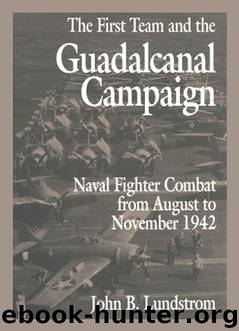First Team and the Guadalcanal Campaign: Naval Fighter Combat from August to November 1942 by Lundstrom John B

Author:Lundstrom, John B.
Language: eng
Format: epub
ISBN: 978-1-6125-1165-8
Publisher: Naval Institute Press
Published: 2013-06-10T16:00:00+00:00
15 OCTOBER
Ashore
Before dawn Vandegrift radioed Ghormley that no landings had indeed occurred at Lunga. However, as dawn broke six transports had anchored “brazen and bold”31 about 15 miles west, a gauntlet thrown at the feet of the 1st MAW. Takama risked daylight air attack to rush as many men ashore as he could. He hoped Mikawa’s bombardment had neutralized the enemy air force at Lunga, and that 17th Army artillery would successfully interdict the airfield. The Japanese took elaborate steps to protect the convoy. Before dawn six Type 0 observation seaplanes under WO Matsuoka Chikara flew down from Rekata, and at 0800 Lieutenant Kofukuda’s twelve Zero 32s arrived from Buin. Eleven Junyō Zeros were en route from Kondō’s 2nd Carrier Division northeast of Guadalcanal. Other flights were scheduled to relieve these aircraft.32
Search planes from BUTTON spotted the night Express, as well as Mikawa’s bombardment force, but the immediate problem at hand was the six transports off the beach just west of Kokumbona covered by destroyers steaming between Savo and Guadalcanal. Geiger’s aviators were eager to plaster these fat targets right within sight of Lunga. At Fighter 1 VF-5 had three F4Fs in commission along with perhaps twenty Marine Wildcats, but only three SBDs could fly, although crews labored hard to repair more. The SBDs had to taxi over rough dirt the mile or so from Henderson Field to Fighter 1. Only one made it. Even though he could not retract his wheels or extend his flaps, 1st Lt. Robert M. Patterson of VMSB-141 made the first of a series of pennypacket assaults, whose exact sequence cannot now be determined.
Pat Rooney and Smokey Stover of VF-5 flew the first fighter strike of the day.33 Taking off about 0800, they quickly attained 7,000 feet. Black AA bursts chased them even before they pushed over west of Point Cruz to strafe three transports anchored in line off the beach. Barreling in “below masthead height,” they shot into the slab-sided vessels, roughed up a landing barge, then recovered inland, where they turned right toward rugged Cape Esperance and flew through a valley. The two F4Fs reversed course to have a another go at the same targets, this time from the opposite side.
Recovering from his second run, Stover zoomed back to 7,000 feet bound for Lunga. Suddenly he spotted a Type 0 observation seaplane diving at him from behind. It was the Sanuki Maru’s Q-178, flown by PO1c Sakuma Kiichi with Sea1c Yoshimitsu Shigeru as observer. They were well acquainted with VF-5, having fought both the 14 September and 8 October battles. Stover countered by turning sharply and climbing, but Sakuma clung to his tail. At 8,000 feet, Stover confronted his pursuer with a long, nearly head-on attack. Sakuma shot first, but the 7.7-mm tracers “dribbed off to the right.” At 500 yards Stover replied with four .50s, also underled his target, and missed. As if mesmerized, neither pilot pulled out of his run in time to avoid colliding. Stover’s right wing sliced through one of the biplane’s fabric-covered right wings and tore away the wing strut.
Download
This site does not store any files on its server. We only index and link to content provided by other sites. Please contact the content providers to delete copyright contents if any and email us, we'll remove relevant links or contents immediately.
| Africa | Americas |
| Arctic & Antarctica | Asia |
| Australia & Oceania | Europe |
| Middle East | Russia |
| United States | World |
| Ancient Civilizations | Military |
| Historical Study & Educational Resources |
Before Topgun Days: The Making of a Jet Fighter Instructor by Dave Baranek(793)
Enemy Coast Ahead by Guy Gibson(685)
The SAS Training Manual by Chris McNab;(673)
The True Story of Catch 22 by Patricia Chapman Meder(587)
Comet! The World’s First Jet Airliner by Graham Simons(581)
Outlaws Inc. by Matt Potter(567)
Airborne by Tom Clancy(528)
The Other Side of Airfix by Authur Ward(525)
The Wright Company by Edward J. Roach(524)
Memoirs of a Stuka Pilot by Helmut Mahlke(508)
Beyond Band of Brothers by Richard D. Winters(500)
Hitler's Eagles by Chris McNab(496)
Air Warriors by Douglas Waller(467)
Boyd by Robert Coram(459)
Stormchasers by David Toomey(451)
Pegasus, The Heart of the Harrier: The History and Development of the World's First Operational Vertical Take-off and Landing Jet Engine by Andrew Dow(448)
Airborne (1997) by Clancy Tom(446)
Focke-Wulf Fw 190 by CHRIS GOSS(424)
I Always Wanted to Fly by Wolfgang W. E. Samuel(409)
